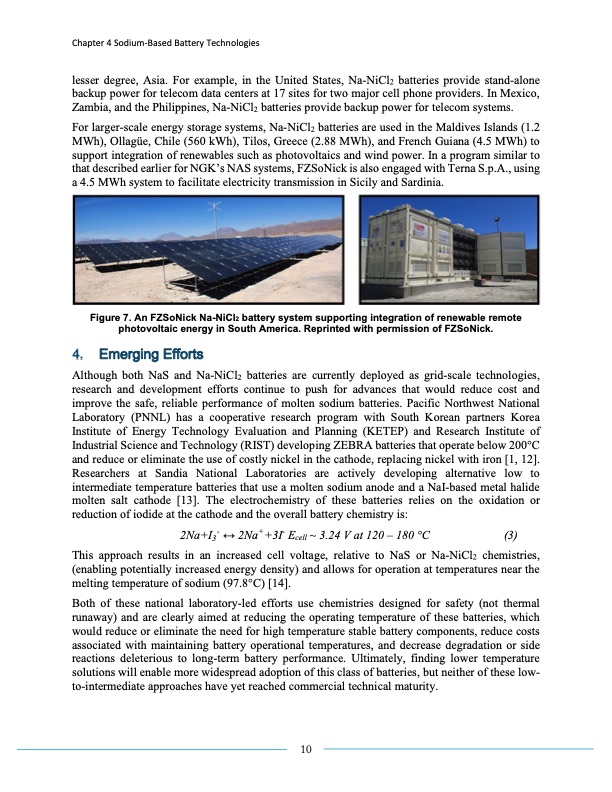
PDF Publication Title:
Text from PDF Page: 010
Chapter 4 Sodium-Based Battery Technologies lesser degree, Asia. For example, in the United States, Na-NiCl2 batteries provide stand-alone backup power for telecom data centers at 17 sites for two major cell phone providers. In Mexico, Zambia, and the Philippines, Na-NiCl2 batteries provide backup power for telecom systems. For larger-scale energy storage systems, Na-NiCl2 batteries are used in the Maldives Islands (1.2 MWh), Ollagüe, Chile (560 kWh), Tilos, Greece (2.88 MWh), and French Guiana (4.5 MWh) to support integration of renewables such as photovoltaics and wind power. In a program similar to that described earlier for NGK’s NAS systems, FZSoNick is also engaged with Terna S.p.A., using a 4.5 MWh system to facilitate electricity transmission in Sicily and Sardinia. Figure 7. An FZSoNick Na-NiCl2 battery system supporting integration of renewable remote photovoltaic energy in South America. Reprinted with permission of FZSoNick. Emerging Efforts Although both NaS and Na-NiCl2 batteries are currently deployed as grid-scale technologies, research and development efforts continue to push for advances that would reduce cost and improve the safe, reliable performance of molten sodium batteries. Pacific Northwest National Laboratory (PNNL) has a cooperative research program with South Korean partners Korea Institute of Energy Technology Evaluation and Planning (KETEP) and Research Institute of Industrial Science and Technology (RIST) developing ZEBRA batteries that operate below 200°C and reduce or eliminate the use of costly nickel in the cathode, replacing nickel with iron [1, 12]. Researchers at Sandia National Laboratories are actively developing alternative low to intermediate temperature batteries that use a molten sodium anode and a NaI-based metal halide molten salt cathode [13]. The electrochemistry of these batteries relies on the oxidation or reduction of iodide at the cathode and the overall battery chemistry is: 2Na+I3- ↔ 2Na++3I- Ecell ~ 3.24 V at 120 – 180 °C (3) This approach results in an increased cell voltage, relative to NaS or Na-NiCl2 chemistries, (enabling potentially increased energy density) and allows for operation at temperatures near the melting temperature of sodium (97.8°C) [14]. Both of these national laboratory-led efforts use chemistries designed for safety (not thermal runaway) and are clearly aimed at reducing the operating temperature of these batteries, which would reduce or eliminate the need for high temperature stable battery components, reduce costs associated with maintaining battery operational temperatures, and decrease degradation or side reactions deleterious to long-term battery performance. Ultimately, finding lower temperature solutions will enable more widespread adoption of this class of batteries, but neither of these low- to-intermediate approaches have yet reached commercial technical maturity. 10PDF Image | SODIUM-BASED BATTERY TECHNOLOGIES CH 4

PDF Search Title:
SODIUM-BASED BATTERY TECHNOLOGIES CH 4Original File Name Searched:
ESHB_Ch4_Sodium_Spoerke-1.pdfDIY PDF Search: Google It | Yahoo | Bing
Salgenx Redox Flow Battery Technology: Salt water flow battery technology with low cost and great energy density that can be used for power storage and thermal storage. Let us de-risk your production using our license. Our aqueous flow battery is less cost than Tesla Megapack and available faster. Redox flow battery. No membrane needed like with Vanadium, or Bromine. Salgenx flow battery
| CONTACT TEL: 608-238-6001 Email: greg@salgenx.com | RSS | AMP |